Analysis of Rural Heritage House Facades as the Initial Step Towards Their Adaptive Reuse and Renovation: A Case Study of Sixteen Houses in Mazandaran Province, Iran
Abstract
1. Introduction
1.1. Analysis as the Initial Step of Transformation Processes
1.2. Brief Review of the Formal Approach
2. Materials and Methods
- Which are the oldest houses in this village?
- What historical period are they from?
- Who are/were their owners, and what social class were they from?
- 4.
- Why was your house or your ancestors’ house built this way (in terms of shape, materials, or structure)?
- 5.
- What kind of peripheral work has been carried out in or around the house?
3. Results
3.1. Mazandaran Province
The Main Elements of the Exterior Facades of Historical Rural Houses in Mazandaran
- -
- Porch
- -
- Roof
- -
- Facade proportion
- -
- Materials
3.2. Selected Villages
3.3. Analysis of the Houses
3.3.1. Mountainous Zone: Alasht
3.3.2. Foothill Zone: Bourkhani and Naftechal of Lafour
3.3.3. Plain Zone: Reikandeh and Kutena of Qaemshahr
4. Discussion
4.1. General Pattern
4.2. Porch Pattern
4.3. Openings
4.4. Facade Proportion
4.5. Sloping Roof
4.6. Facade Ornaments
4.7. Balustrade Pattern
4.8. Materials and Structure
5. Conclusions
Author Contributions
Funding
Data Availability Statement
Acknowledgments
Conflicts of Interest
References
- Demolition of Historical Rural Houses of Alasht. 2013. Available online: https://www.isna.ir/news/92060100092/%D8%AA%D8%AE%D8%B1%DB%8C%D8%A8-%D8%AE%D8%A7%D9%86%D9%87-%D9%87%D8%A7%DB%8C-%D8%AA%D8%A7%D8%B1%DB%8C%D8%AE%DB%8C-%D8%A2%D9%84%D8%A7%D8%B4%D8%AA (accessed on 25 June 2024).
- Gharakhlou, M.; Khalilabad, H.K.; Eskandari node, M. Study on Transformation in Structural and Architectural Construction of Village and Formation of Rural-Towns. Hum. Geogr. Res. 2008, 41, 53–70. [Google Scholar]
- Alalhesabi, M. Necessity of a new approach in rural development and construction. J. Hous. Rural Environ. (Hous. Revolut.) 2002, 14–23. [Google Scholar]
- Arfa, F.H.; Pottgiesser, U. Roundtable VII: Time and Unlisted Heritage; TU Delft Open: Delft, The Netherlands, 2021. [Google Scholar]
- Delfanian, H.; Khakzand, M.; Kamyabi, S. Identifying the Relationship between Vernacular Architecture & Climate through Studying Thermal Comfort Indicators in Nowshahr City. Arman. Archit. Urban Dev. 2019, 11, 69–79. [Google Scholar]
- Posht, A.R.; Daneshjoo, K.; Mofidi-Shemirani, S.-M. Balcony Effect on Thermal Performance of the Building and Its Climate Assessment in Local Houses in Mazandaran Province. J. Comput. Theor. Nanosci. 2019, 16, 5265–5276. [Google Scholar] [CrossRef]
- Yousefniapasha, M.; Teeling, C.; Rollo, J.; Bunt, D. Shape grammar, culture, and generation of vernacular houses (a practice on the villages adjacent to rice fields of Mazandaran, in the north of Iran). Environ. Plan. B Urban Anal. City Sci. 2019, 48, 94–114. [Google Scholar] [CrossRef]
- Arfa, F.H. Adaptive Reuse of Heritage Buildings: From a Literature Review to a Model of Practice. Hist. Environ. Policy Pract. 2022, 3, 148–170. [Google Scholar] [CrossRef]
- Arfa, F.H.; Quist, W.; Lubelli, B.; Zijlstra, H. Architects’ Methodology in Adaptive Reuse of Heritage Buildings. In As Found International Colloquium on Adaptive Reuse; Augustiniok, N., Ed.; Hasselt University: Hasselt, Belgium, 2023; pp. 134–135. [Google Scholar]
- Arfa, F.H.; Lubelli, B.; Quist, W.; Zijlstra, H. A model of the adaptive reuse process of heritage buildings: Validation on four cases in the Netherlands. Des. Stud. 2024, 91–92, 101252. [Google Scholar] [CrossRef]
- Misirlisoy, D.; Günçe, K. Adaptive reuse strategies for heritage buildings: A holistic approach. Sustain. Cities Soc. 2016, 26, 91–98. [Google Scholar] [CrossRef]
- Arfa, F.H.; Lubelli, B.; Zijlstra, H.; Quist, W. Criteria of ‘Effectiveness’ and Related Aspects in Adaptive Reuse Projects of Heritage Buildings. Sustainability 2022, 14, 1251. [Google Scholar] [CrossRef]
- Aita, D.; Barsotti, R.; Bennati, S. Studying the dome of pisa cathedral via a modern reinterpretation of durand-claye’s method. J. Mech. Mater. Struct. 2019, 14, 603–619. [Google Scholar] [CrossRef]
- Memarian, G. Introduction to Iranian Residential Architecture: Extroverted Typology; Soroush Danesh Cultural Institute: Tehran, Iran, 2008. [Google Scholar]
- Chebaiki, L.; Chemrouk, N.C. Moorish Architectural Syntax and the Reference to Nature: A Case Study of Algiers; WIT Transactions on the Built Environment: Cambridge, MA, USA, 2014. [Google Scholar]
- Steadman, P. The Evolution of Designs: Biological Analogy in Architecture and the Applied Arts; Routledge: London, UK, 2008. [Google Scholar]
- Memarian, G. A Look at the Theoretical Foundations of Architecture; Soroush Danesh Publications: Tehran, Iran, 2005. [Google Scholar]
- General Department of Information Statistics of the Agriculture Ministry. Atlas of Land Use and Coverage of Mazandaran Province Using Satellite Information Scale 1: 200,000; Ministry of Agriculture Publications: Tehran, Iran, 1997. [Google Scholar]
- Statistical Center of Iran. Country Statistical Yearbook of 1385; Information Office and Statistical Database: Tehran, Iran, 2007. [Google Scholar]
- Mazandaran Province’s Management and Planning Organization. The Study Program of Mazandaran Province: A Study of Situation and Structure Analysis; Mazandaran Province’s Management and Planning Organization: Danesh, Iran, 2005; pp. 1–135. [Google Scholar]
- Bahrani, M.H. In the Realm of Mazandaran: Article Series of Climate, Human and Activities in Mazandaran Province (the Language of Statistics); Babel Publication: Naghsh-e-Jahan, Iran, 1966; Volume 1. [Google Scholar]
- Tahbaz, M.; Djalilian, S. Compatibility indicators with climate in rural housing of gilan province. Hous. Rural Environ. 2011, 30, 23–42. [Google Scholar]
- Raheb, G. Typology of housing formation zones in rural settlements of Iran in interaction with environmental factors. J. Fine Arts Archit. Urban Plan. 2014, 19, 87–100. [Google Scholar]
- Sartipipour, M. Architecture of native folk houses in the villages of Markazi province. Phys. Dev. Plan. Q. 2013, 1, 25–36. [Google Scholar]
- Mahlabani, Y.G.; Daneshvar, K. Impact of climate on the principles of Gilan traditional architecture. J. Arman. 2010, 3, 135–145. [Google Scholar]
- Zargar, A.H.E. An Introduction to Understanding Rural Architecture in Iran; Shahid Beheshti University Publishing Center: Tehran, Iran, 2011. [Google Scholar]
- Sartipipour, M. Pathology of Rural Architecture to the Desired Settlement; Islamic Revolution Housing Foundation and Shahid Beheshti University: Tehran, Iran, 2009. [Google Scholar]
- Sartipipour, M. Housing architecture in Iranian villages. J. Hous. Rural Environ. (Hous. Revolut.) 2007, 119, 2–15. [Google Scholar]
- Pirzad, A.; Riyahimoghadam, S. Investigating the relationship between localism in rural architecture and rural economy in the central areas of Mazandaran and central areas of Yazd. Two Res. Q. J. Nativ Art Stud. 2014, 2, 43–62. [Google Scholar]

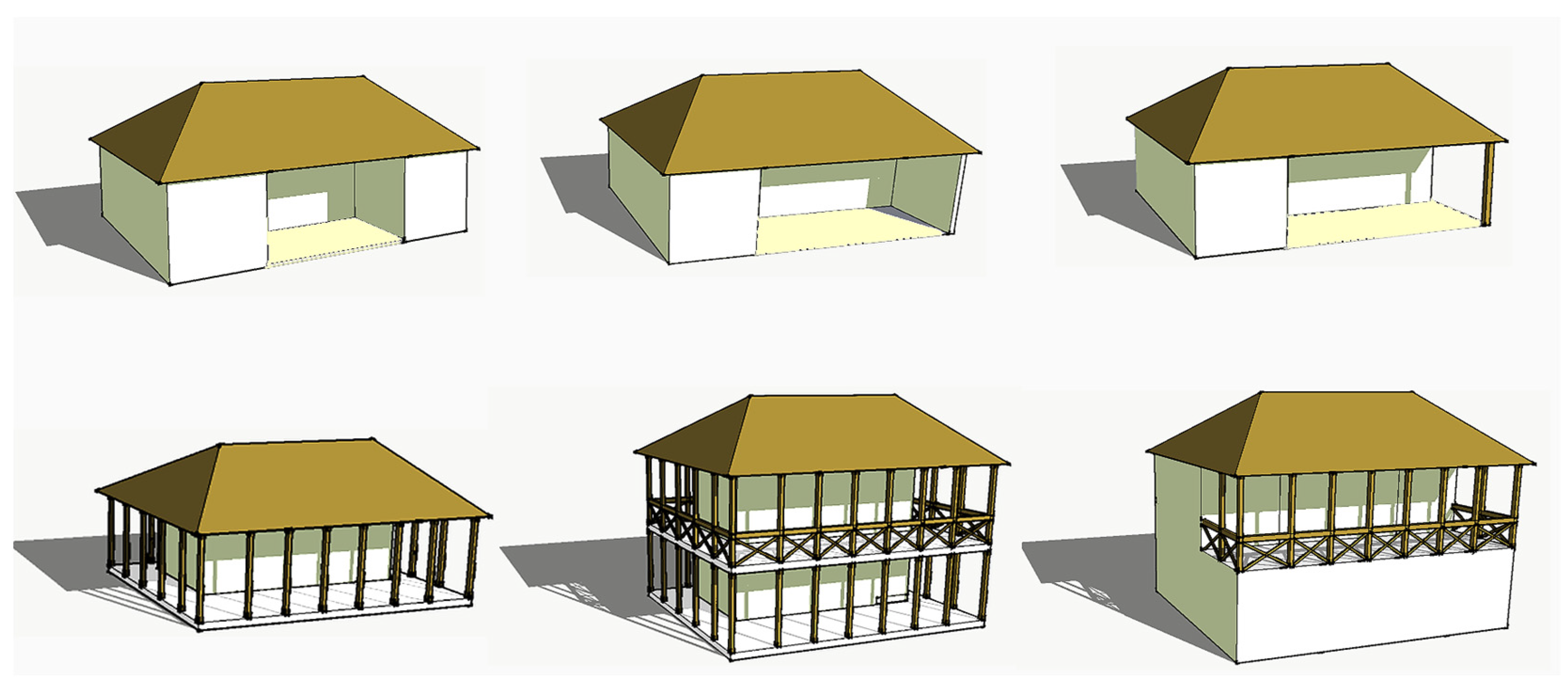
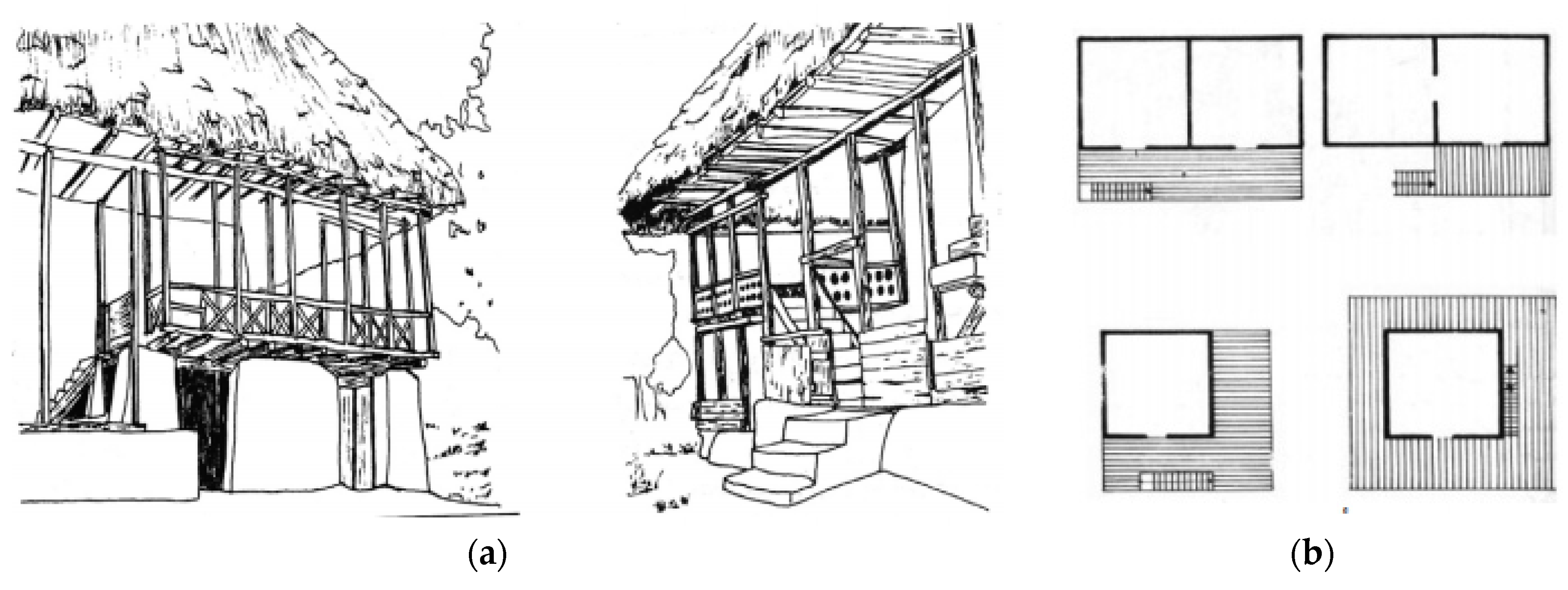

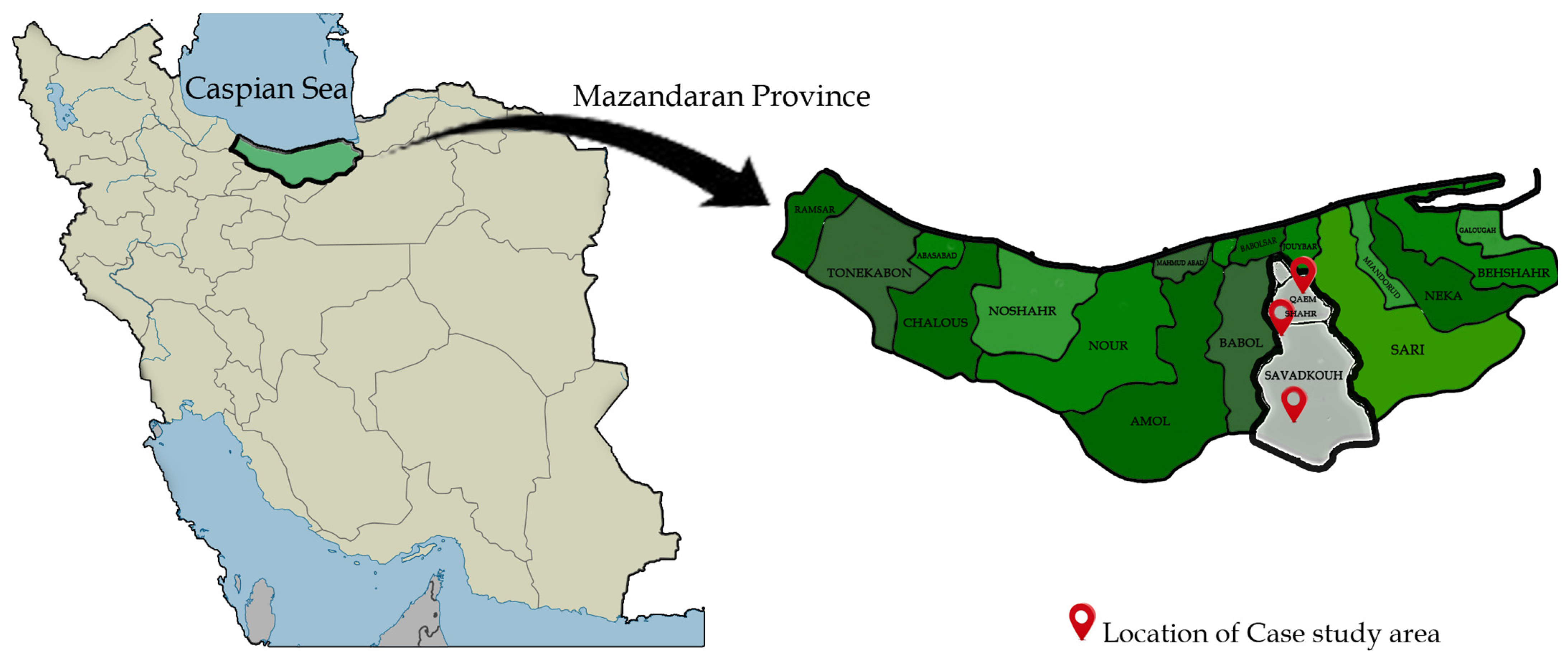
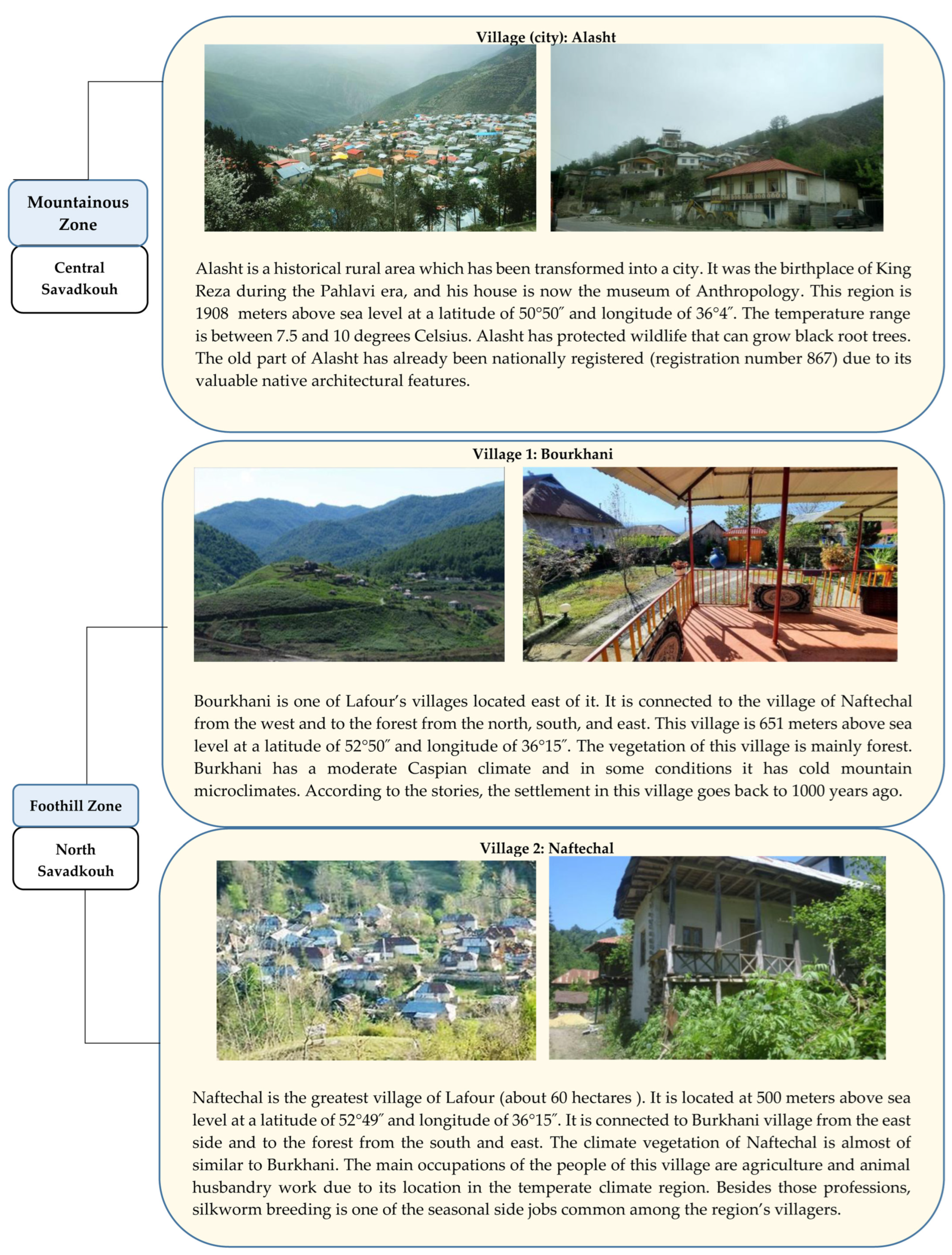
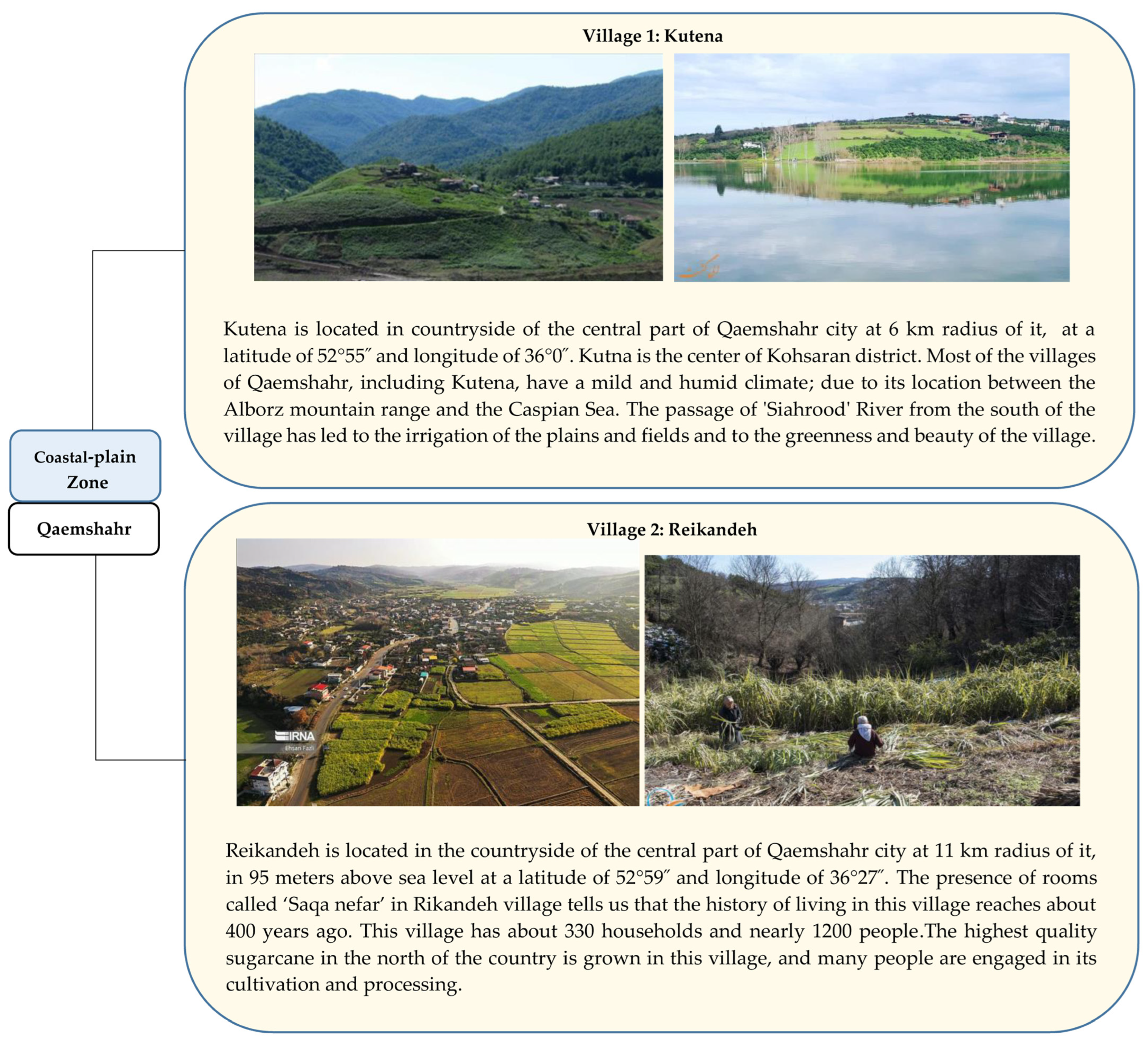
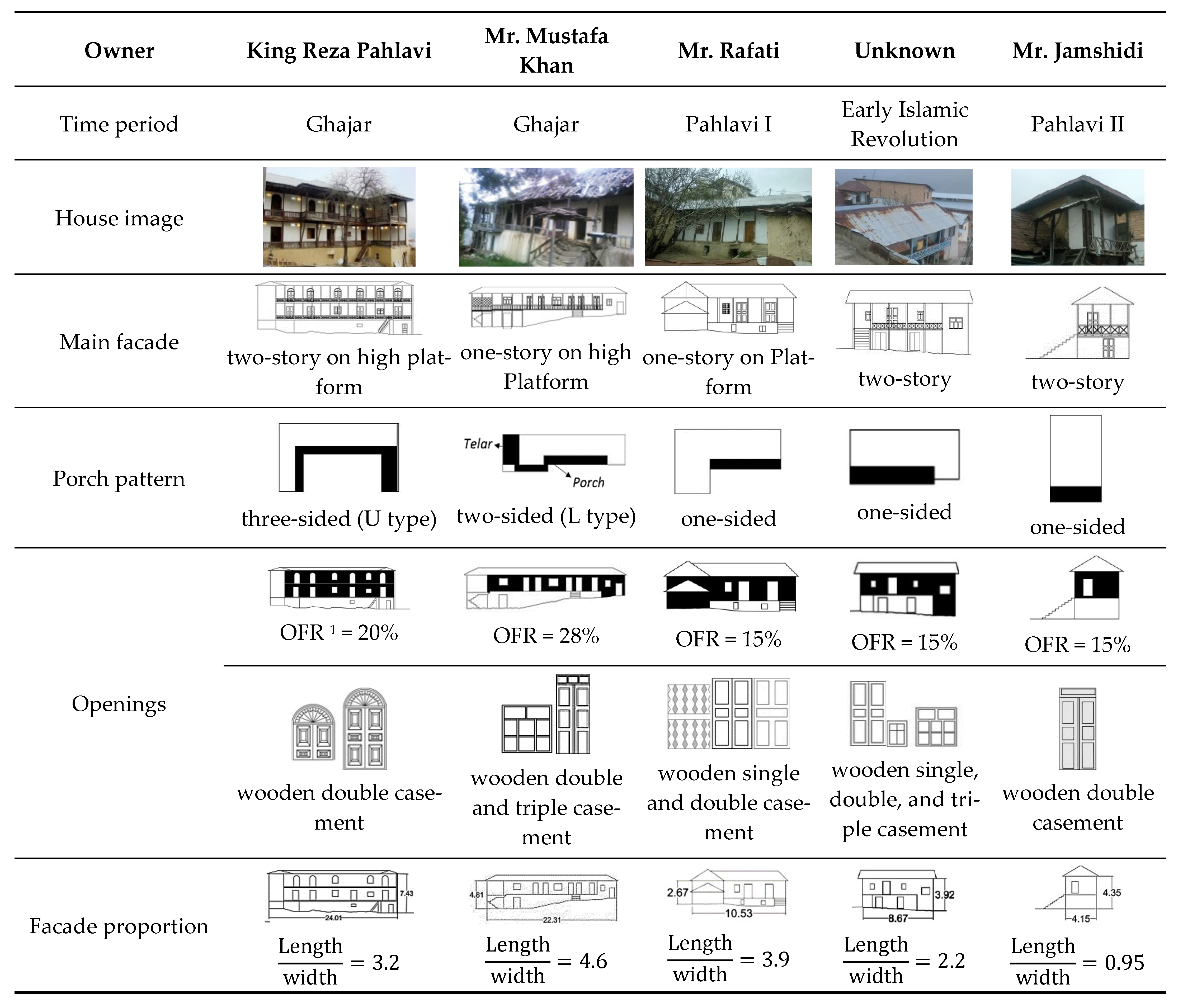
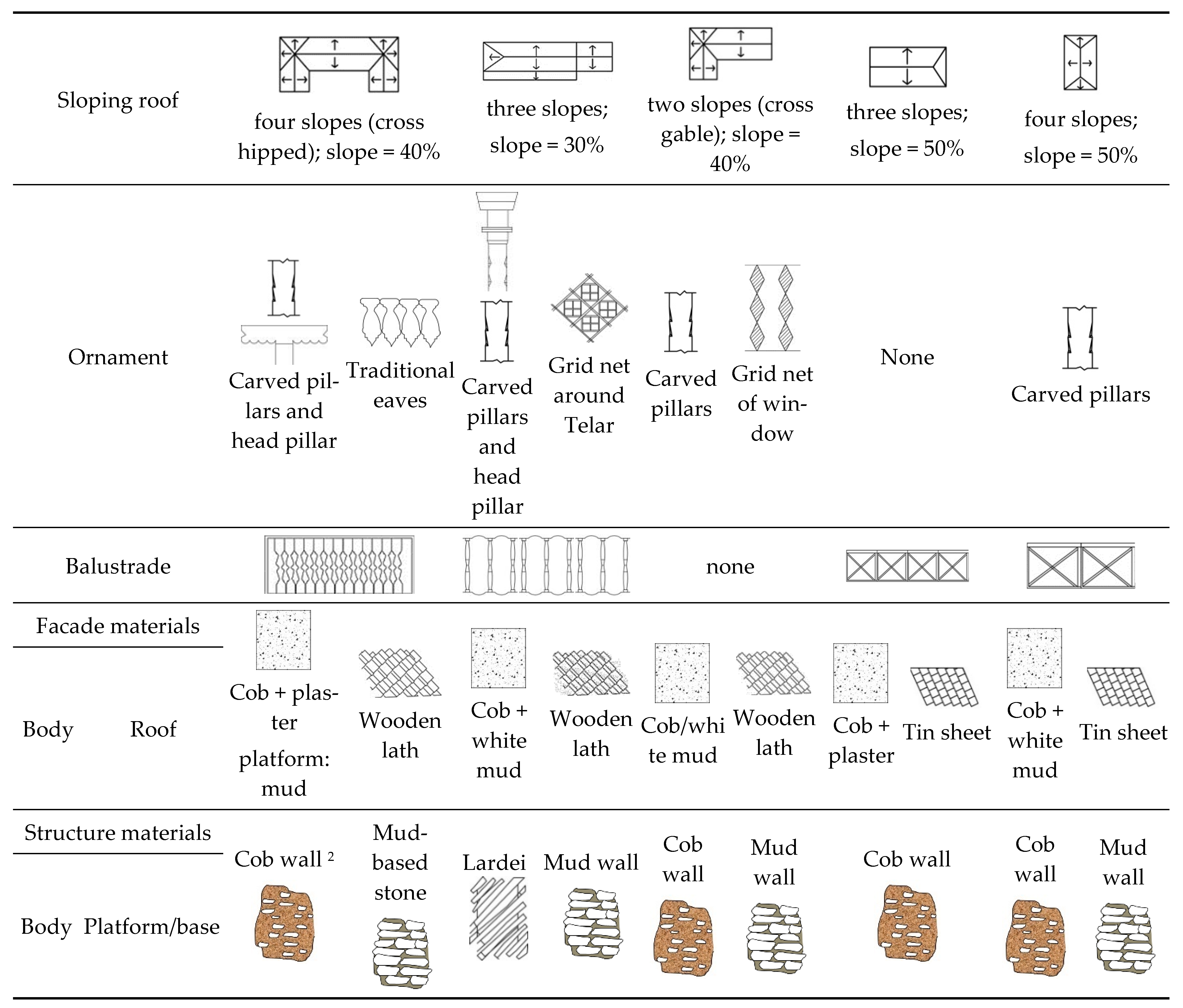
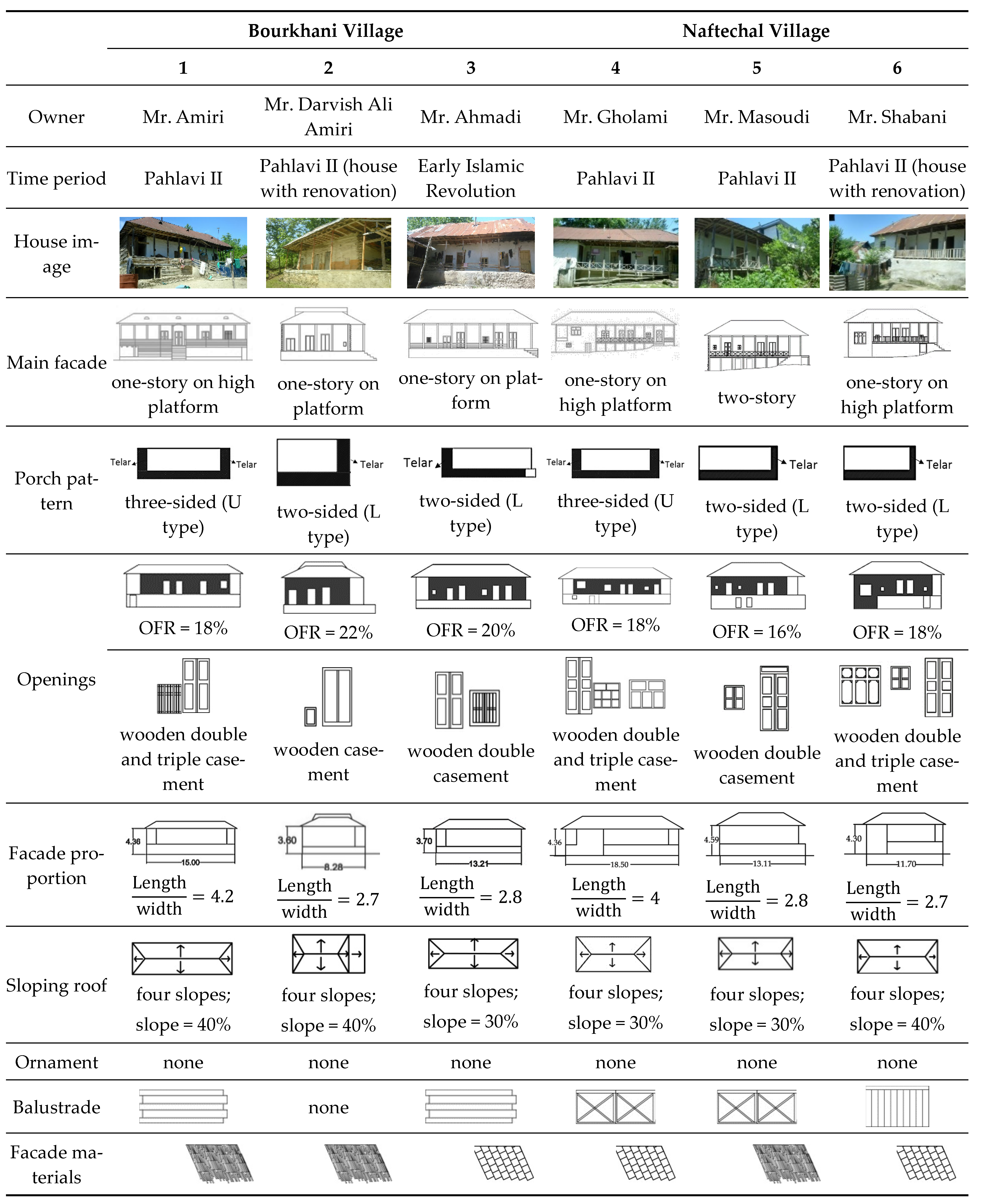
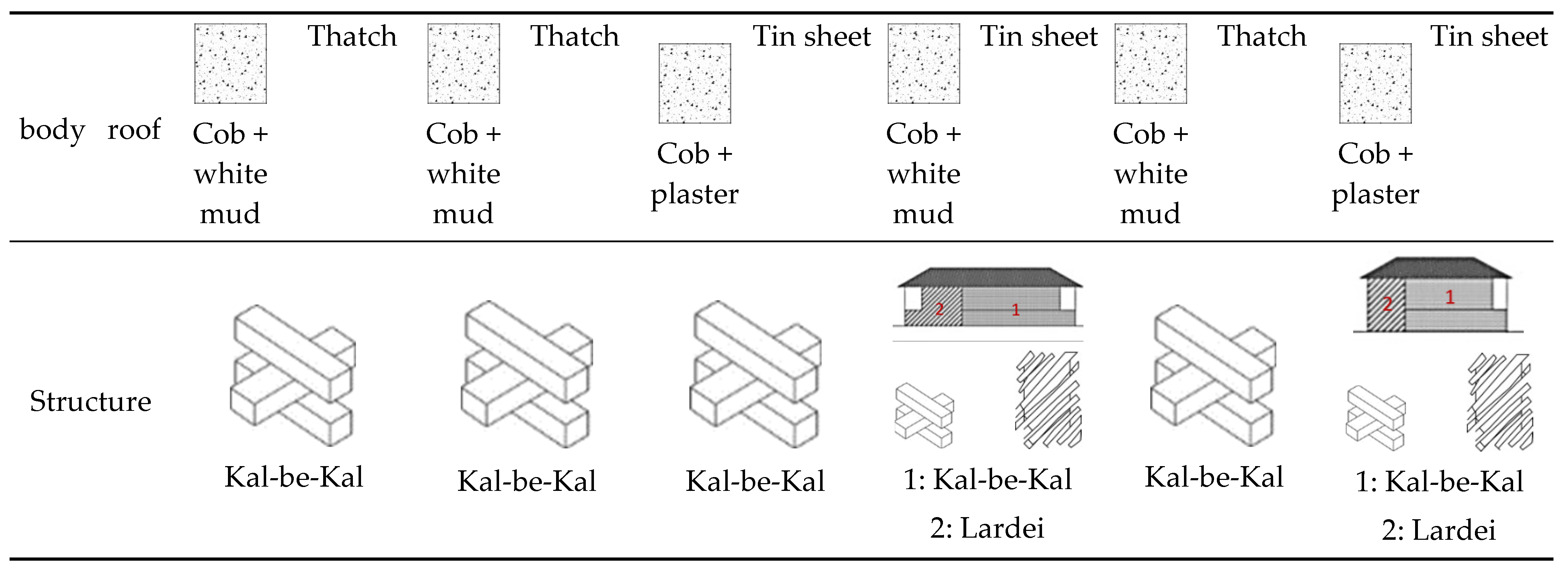
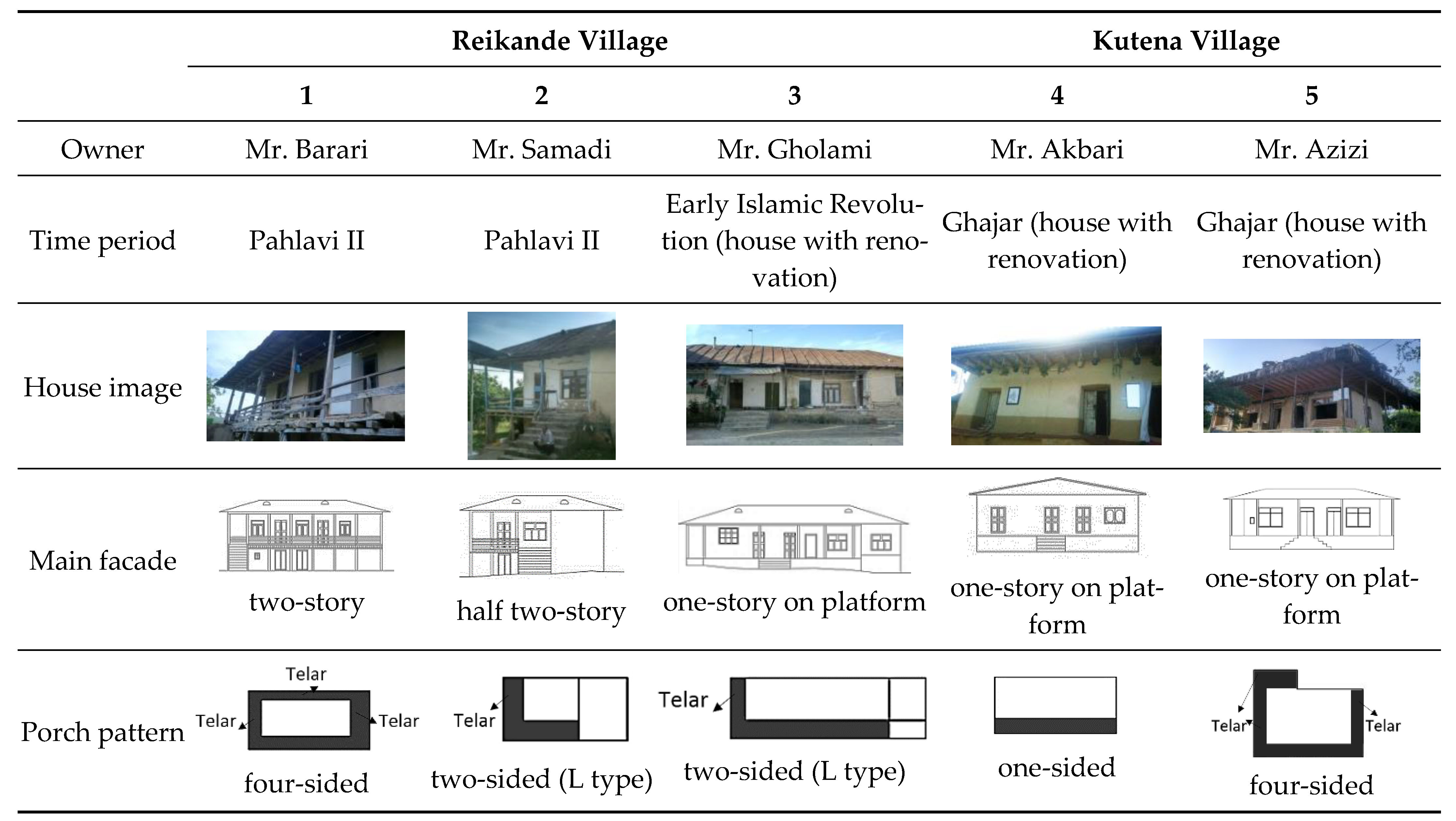
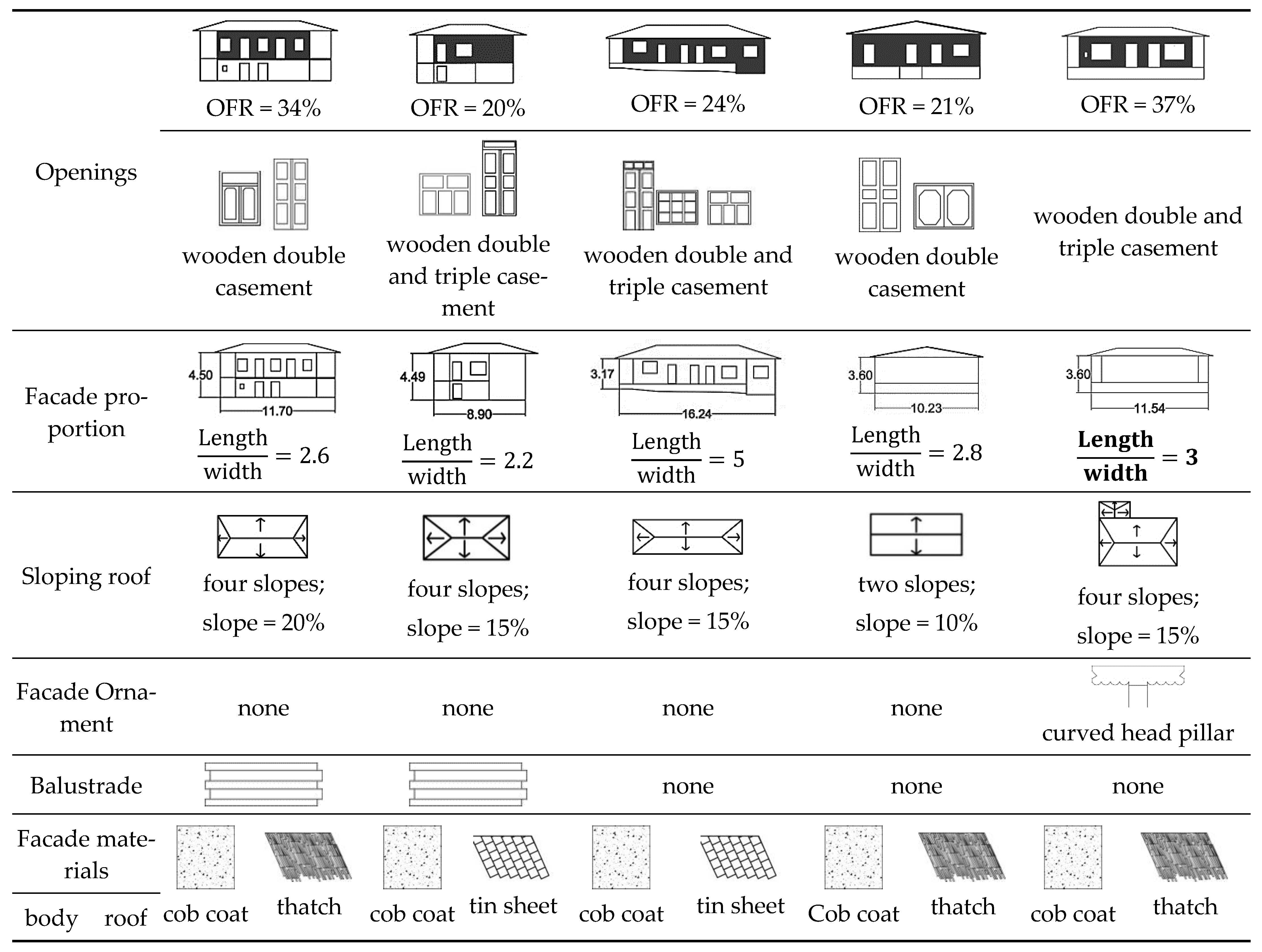







| Zone Name | Explanations |
|---|---|
| Plain zone | The plain zone of the province has a slope of 0–1% [20] and is located below an altitude of 100 m above sea level [22]. |
| Foothill zone | The foothill zone is situated between an altitude of 100 and 500 m above sea level, and in some cases, it extends up to 800 m [22]. This zone includes the Caspian Hyrcanian mixed forests and boasts the most convenient climatic conditions among the zones. |
| Mountainous zone | This zone is located at 500 m above sea level and has a relatively high slope from south to north and west to east [22]. The Alborz mountains in the mountainous zone separate Mazandaran from the south of Alborz, and like a long wall, they extend from west to east near Gorgan Valley [21]. |
Disclaimer/Publisher’s Note: The statements, opinions and data contained in all publications are solely those of the individual author(s) and contributor(s) and not of MDPI and/or the editor(s). MDPI and/or the editor(s) disclaim responsibility for any injury to people or property resulting from any ideas, methods, instructions or products referred to in the content. |
© 2024 by the authors. Licensee MDPI, Basel, Switzerland. This article is an open access article distributed under the terms and conditions of the Creative Commons Attribution (CC BY) license (https://creativecommons.org/licenses/by/4.0/).
Share and Cite
Ahmadi, S.; Arfa, F.H.; Seyedian, S.A. Analysis of Rural Heritage House Facades as the Initial Step Towards Their Adaptive Reuse and Renovation: A Case Study of Sixteen Houses in Mazandaran Province, Iran. Buildings 2024, 14, 1938. https://doi.org/10.3390/buildings14071938
Ahmadi S, Arfa FH, Seyedian SA. Analysis of Rural Heritage House Facades as the Initial Step Towards Their Adaptive Reuse and Renovation: A Case Study of Sixteen Houses in Mazandaran Province, Iran. Buildings. 2024; 14(7):1938. https://doi.org/10.3390/buildings14071938
Chicago/Turabian StyleAhmadi, Soufia, Fatemeh Hedieh Arfa, and Seyed Ali Seyedian. 2024. "Analysis of Rural Heritage House Facades as the Initial Step Towards Their Adaptive Reuse and Renovation: A Case Study of Sixteen Houses in Mazandaran Province, Iran" Buildings 14, no. 7: 1938. https://doi.org/10.3390/buildings14071938
APA StyleAhmadi, S., Arfa, F. H., & Seyedian, S. A. (2024). Analysis of Rural Heritage House Facades as the Initial Step Towards Their Adaptive Reuse and Renovation: A Case Study of Sixteen Houses in Mazandaran Province, Iran. Buildings, 14(7), 1938. https://doi.org/10.3390/buildings14071938





